Category: QuickStats
QuickStats: Mental Health Treatment Trends Among Adults Aged ≥18 Years, by Age Group — United States, 2019–2023
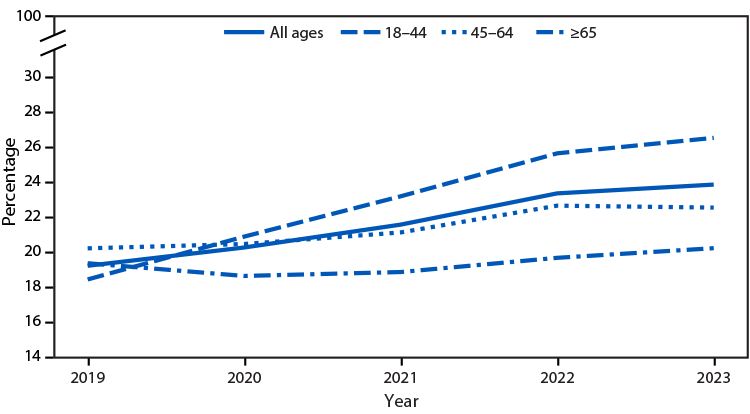
From 2019 to 2023, the percentage of adults who had received any mental health treatment during the past 12 months increased from 19.2% to 23.9%. This pattern was similar among adults aged 18–44 and 45–64 years. No significant change was observed among adults aged ≥65 years. Supplementary Table: https://stacks.cdc.gov/view/cdc/174552 Source: National Center for Health Statistics, National Health Read More >
Posted on byQuickStats: Age-Adjusted Percentage of Adults Aged ≥18 Years with Diagnosed Chronic Obstructive Pulmonary Disease, by Urbanization Level — United States, 2023
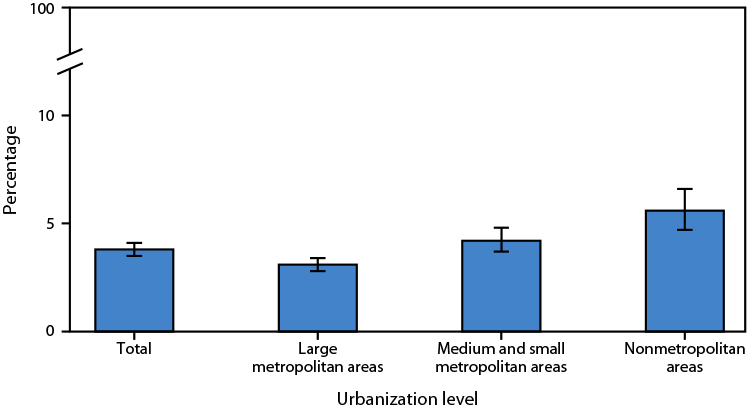
In 2023, the age-adjusted percentage of adults aged ≥18 years with diagnosed chronic obstructive pulmonary disease (COPD) was 3.8%. The prevalence of COPD among adults increased as urbanization level decreased. Supplementary Table: https://stacks.cdc.gov/view/cdc/168877 Source: National Center for Health Statistics, National Health Interview Survey, 2023. https://www.cdc.gov/nchs/nhis.htm https://www.cdc.gov/mmwr/volumes/73/wr/mm7346a5.htm Read More >
Posted on byQuickStats: Percentage of Adults Aged ≥18 Years Who Were in Families Having Problems Paying Medical Bills in the Past 12 Months, by Disability Status and Age Group — United States, 2023
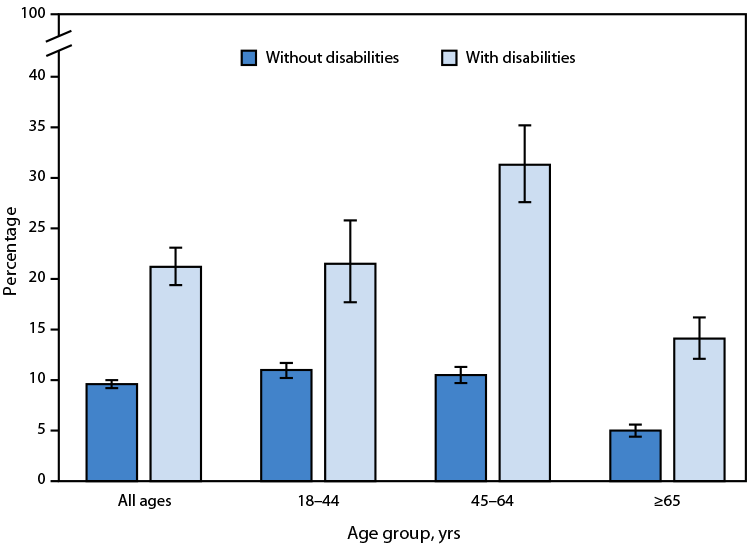
In 2023, the percentage of adults aged ≥18 years who were in families having problems paying medical bills in the past 12 months was higher among those with disabilities (21.2%) compared with those without disabilities (9.6%). This pattern was observed across all age groups. Supplementary Table: https://stacks.cdc.gov/view/cdc/164154 Source: National Center for Health Statistics, National Health Interview Read More >
Posted on byQuickStats: Prevalence of Obesity and Severe Obesity Among Persons Aged 2–19 Years — United States, 1999–2000 Through 2021–2023
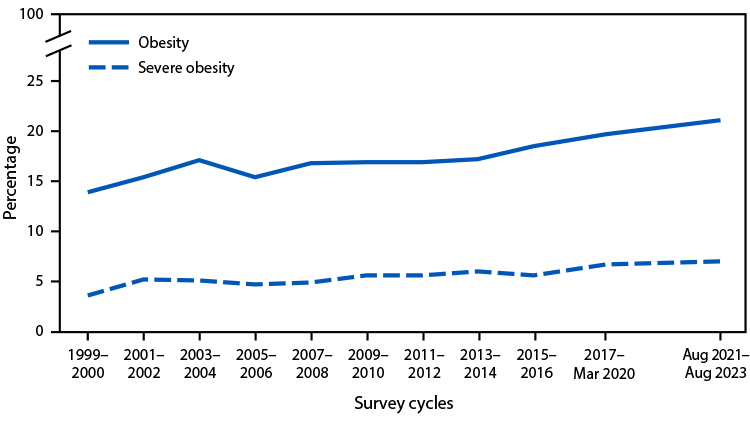
From 1999–2000 through August 2021–August 2023, the prevalence of obesity among persons in the United States aged 2–19 years increased from 13.9% to 21.1%, and the prevalence of severe obesity increased from 3.6% to 7.0%. Supplementary Table: https://stacks.cdc.gov/view/cdc/164014 Source: National Center for Health Statistics, National Health and Nutrition Examination Survey, 1999–2000 through August 2021–August 2023. https://www.cdc.gov/nchs/nhanes/index.htm https://www.cdc.gov/mmwr/volumes/73/wr/mm7341a5.htm Read More >
Posted on byQuickStats: Rates of Emergency Department Visits for Children and Adolescents with Acute Upper Respiratory Infection, by Age Group — United States, 2021–2022
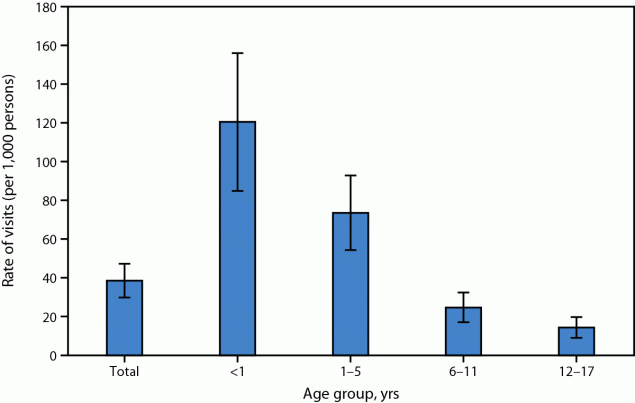
In 2021–2022, the rate for emergency department (ED) visits for children and adolescents with acute upper respiratory infection was 38.6 per 1,000 persons aged <18 years. The ED visit rate was highest for infants aged <1 year (120.5) and decreased by age, with the lowest rate among adolescents aged 12–17 years (14.4). Supplementary Table: https://stacks.cdc.gov/view/cdc/162215 Source: Read More >
Posted on byQuickStats: Percentage of Children and Adolescents Aged ≤17 Years Who Used Telemedicine During the Past 12 Months, by Age Group and Year — United States, 2021–2023
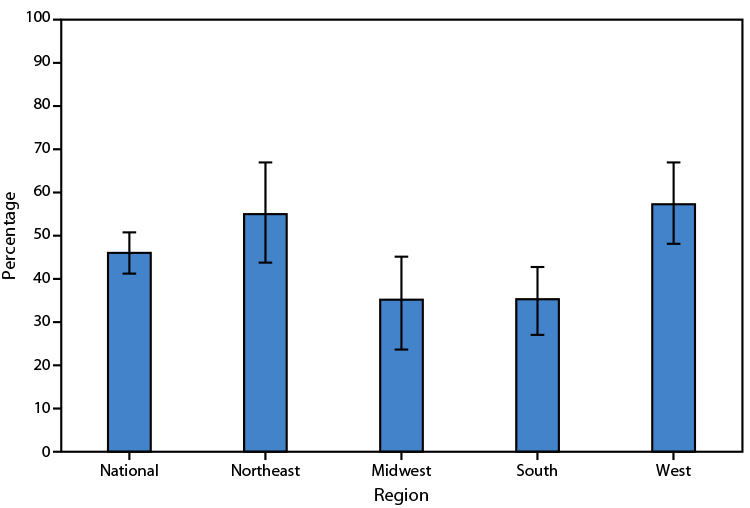
The percentage of children and adolescents aged 0–17 years using telemedicine during the past 12 months declined from 18.3% in 2021 to 14.2% in 2023. Telemedicine use declined across all three age groups during this period. In both 2022 and 2023, telemedicine use increased with age. Supplementary Table: https://stacks.cdc.gov/view/cdc/159160 Source: National Center for Health Statistics, National Health Read More >
Posted on byQuickStats: Percentage of Adult Day Services Centers That Use Any Telehealth, by U.S. Census Bureau Region — United States, 2022

In 2022, 46% of U.S. adult day services centers used any telehealth tools. Approximately one half of centers in the Northeast and West used any telehealth, compared with approximately one third of centers in the Midwest and South. Supplementary Table: https://stacks.cdc.gov/view/cdc/157543 Source: National Center for Health Statistics, National Post-Acute and Long-Term Care Study, 2022. https://www.cdc.gov/nchs/npals https://www.cdc.gov/mmwr/volumes/73/wr/mm7330a4.htm Read More >
Posted on byQuickStats: Percentage of Current Cigarette Smokers Aged ≥18 Years Who Received Advice from a Health Professional To Quit Smoking, by Sex and Age Group — United States, 2022
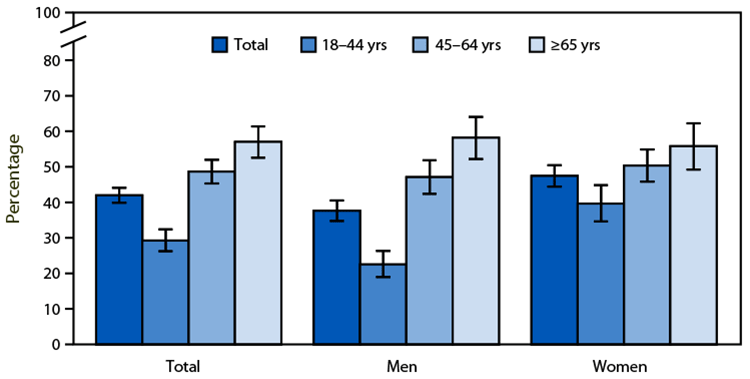
In 2022, 42.0% of current cigarette smokers aged ≥18 years received advice from a doctor, dentist, or other health professional about ways to quit smoking. The percentage of current smokers who received advice to quit smoking increased with age. Overall, and for current smokers aged 18–44 years, men were less likely to receive advice on Read More >
Posted on byQuickStats: Percentage of Adults Aged ≥25 Years Who Met the 2018 Federal Physical Activity Guidelines for Both Muscle-Strengthening and Aerobic Physical Activity, by Educational Attainment — United States, 2022
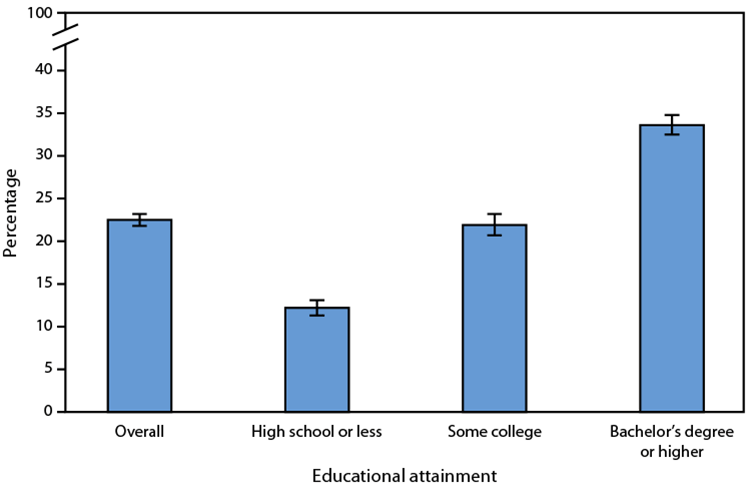
In 2022, 22.5% of adults met federal guidelines for both muscle-strengthening and aerobic physical activity. The percentage of adults who met these guidelines increased with increasing educational attainment, from 12.2% among adults who completed high school or less to 33.6% among those with a bachelor’s degree or higher. Supplementary Table: https://stacks.cdc.gov/view/cdc/155046 Source: National Center for Health Statistics, Read More >
Posted on byQuickStats: Percentage Distribution of Deaths Involving Injuries from Recreational and Nonrecreational Use of Watercraft, by Month — United States, 2020–2022
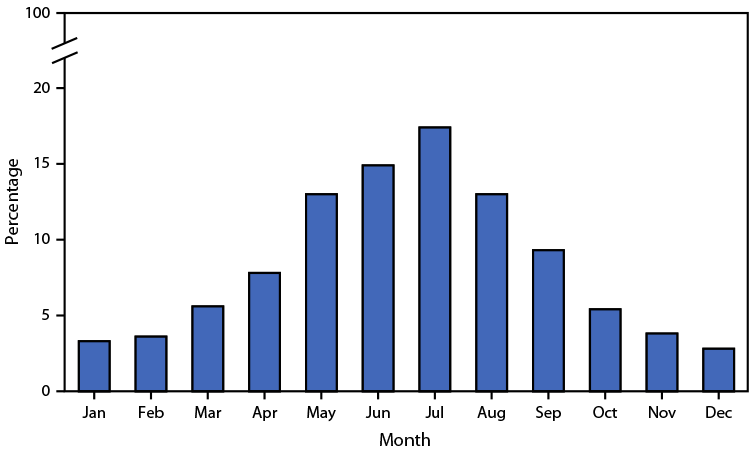
During 2020–2022, a total of 1,481 deaths occurred involving injuries from recreational and nonrecreational use of watercraft. The highest percentage of these deaths (17.4%) occurred in July, with the majority occurring during May–September. Supplementary Table: https://stacks.cdc.gov/view/cdc/155045 Source: National Center for Health Statistics, National Vital Statistics System, Mortality Data, 2020–2022. https://www.cdc.gov/nchs/nvss/deaths.htm Read More >
Posted on byQuickStats: Percentage of Residential Care Communities That Use Electronic Health Records, by Community Bed Size — United States, 2018, 2020, and 2022
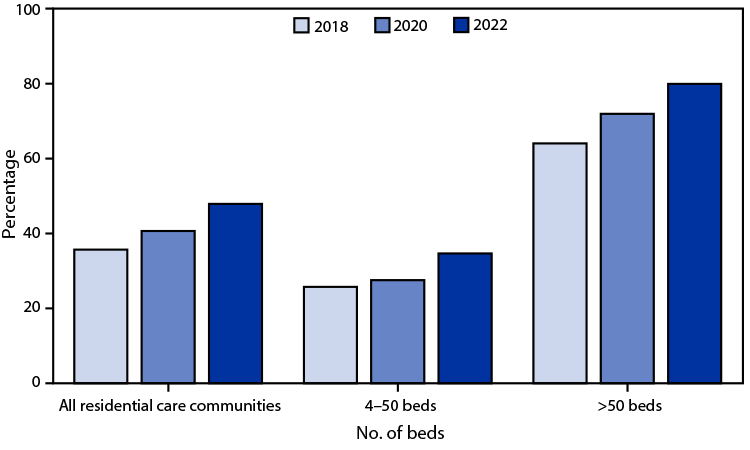
From 2018 to 2022, the percentage of residential care communities (RCCs) using electronic health records (EHRs) increased from 36% to 48%. Use of EHRs increased during this time regardless of RCC size, and larger RCCs were more likely to use EHRs compared with smaller RCCs. Supplementary Table: https://stacks.cdc.gov/view/cdc/153378 Source: National Center for Health Statistics, National Post-acute and Read More >
Posted on byQuickStats: Percentage of Children and Adolescents Aged 3–17 Years Who Ever Received a Diagnosis of Autism Spectrum Disorder, by Family Income, 2020–2022
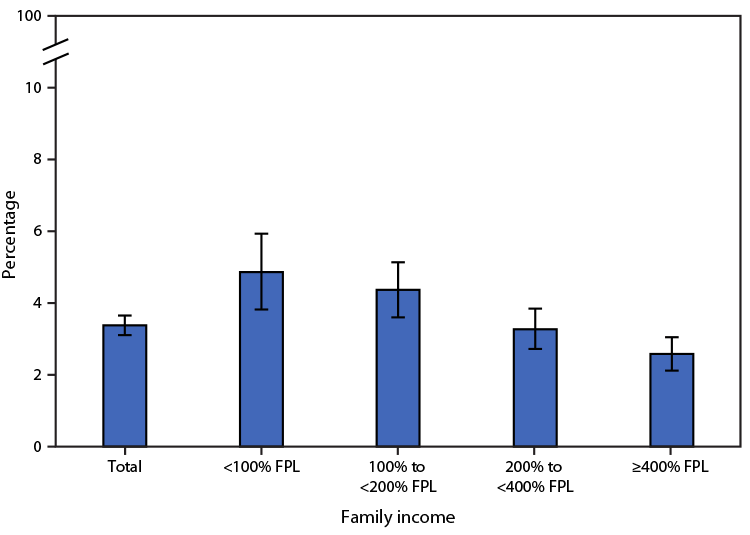
During 2020–2022, 3.4% of children and adolescents aged 3–17 years had received a diagnosis of autism spectrum disorder. The prevalence of autism spectrum disorder among children and adolescents decreased as family income increased. Supplementary Table: https://stacks.cdc.gov/view/cdc/152917 Source: National Center for Health Statistics, National Health Interview Survey, 2020–2022. https://www.cdc.gov/nchs/nhis.htm https://www.cdc.gov/mmwr/volumes/73/wr/mm7315a5.htm Read More >
Posted on byQuickStats: Life Expectancy at Birth, by Sex — United States, 2019–2022
Life expectancy at birth for the U.S. population in 2022 was 77.5 years, an increase from 76.4 years in 2021. Although life expectancy rose in 2022 for the first time since the COVID-19 pandemic began, it remains lower compared with prepandemic life expectancy in 2019 (78.8 years). This pattern was similar for males and females. Read More >
Posted on byQuickStats: Percentage of Children and Adolescents Aged 5–17 Years Who Had Chronic School Absenteeism Due to Illness, Injury, or Disability During the Past 12 Months, by Age Group and Year — National Health Interview Survey, United States, 2019 and 2022
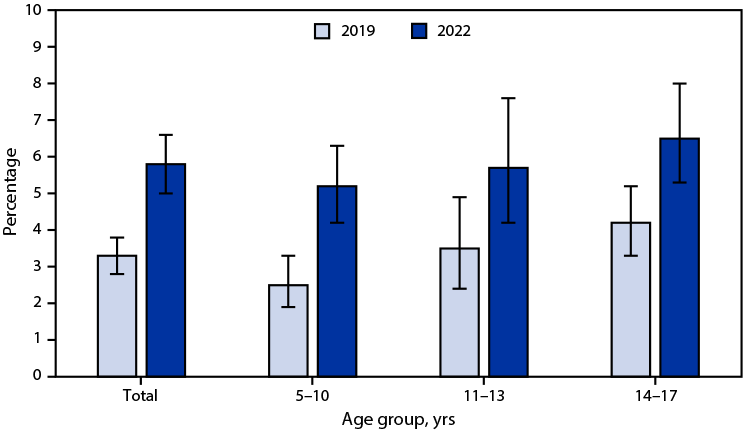
The percentage of children and adolescents aged 5–17 years who had chronic school absenteeism during the past 12 months was higher in 2022 (5.8%) than in 2019 (3.3%). From 2019 to 2022, the percentage of children who had chronic school absenteeism increased for each age group. The percentage of children who had chronic school absenteeism Read More >
Posted on byQuickStats: Percentage of Adults Aged ≥18 Years Who Lacked Reliable Transportation for Daily Living in the Past 12 Months, by Disability Status and Age Group — National Health Interview Survey, United States, 2022
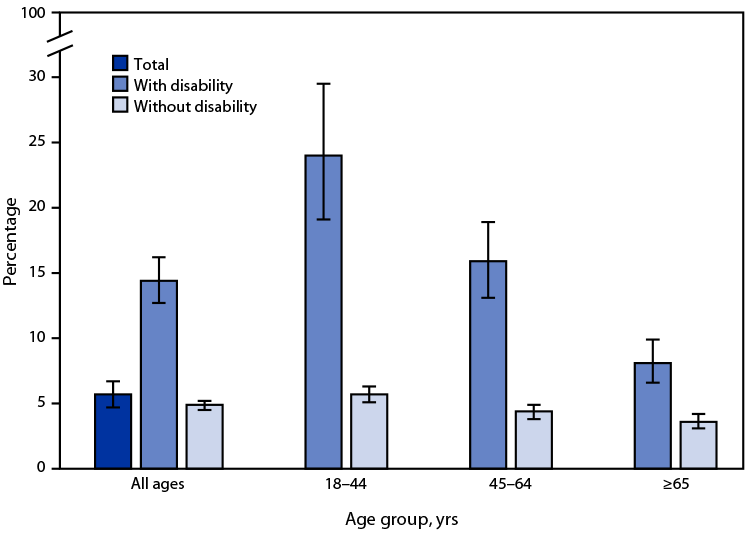
In 2022, 5.7% of adults aged ≥18 years lacked reliable transportation for daily living in the past 12 months. The percentage lacking reliable transportation for daily living among those with disability was higher (14.4%) compared with those without disability (4.9%). The percentages among persons with disability were higher than percentages among those without disability in Read More >
Posted on byQuickStats: Percentage of Newborns Breastfed Between Birth and Discharge from Hospital, by Maternal Age — National Vital Statistics System, 49 States and the District of Columbia, 2021 and 2022
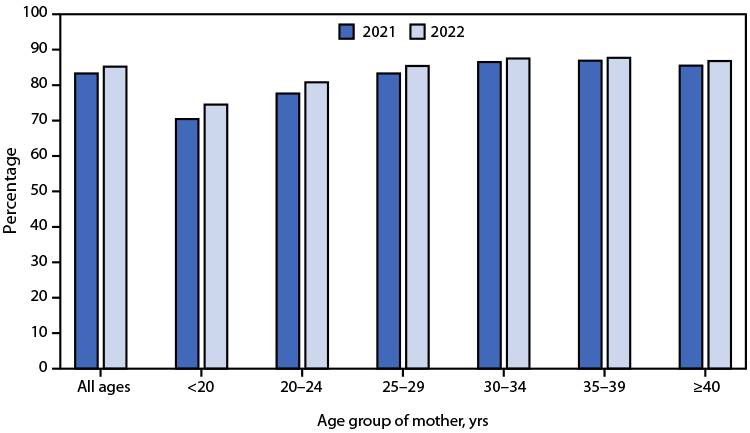
Among 49 states and the District of Columbia, the percentage of newborns breastfed between birth and discharge from the hospital increased from 83.3% in 2021 to 85.2% in 2022. Increases were observed for each maternal age group; the largest increases occurred among younger maternal age groups (70.4% to 74.5% among mothers aged <20 years and Read More >
Posted on byQuickStats: Percentage of Children and Adolescents Aged ≤17 Years Who Visited an Urgent Care Center or a Clinic in a Drug Store or Grocery Store in the Past 12 Months, by Age Group and Year — National Health Interview Survey, United States, 2021–2022
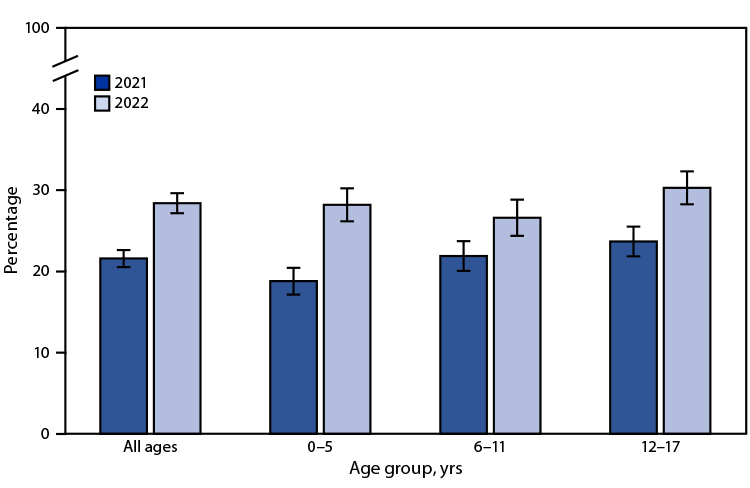
The percentage of children and adolescents aged ≤17 years who had at least one visit to an urgent care center or a clinic in a drug store or grocery store in the past 12 months increased from 21.6% in 2021 to 28.4% in 2022. This increase was noted for all age groups during 2021–2022. In Read More >
Posted on byQuickStats: Percentage of Adults Aged ≥18 Years with Diagnosed Diabetes, by Urbanization Level and Age Group — National Health Interview Survey, United States, 2022
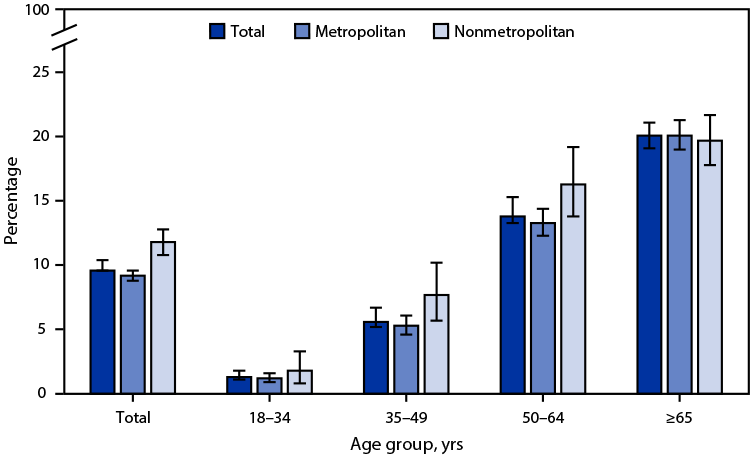
In 2022, 9.6% of adults aged ≥18 years had diagnosed diabetes, with the percentage lower among adults living in metropolitan areas (9.2%) compared with adults in nonmetropolitan areas (11.8%). The prevalence of diagnosed diabetes was lower in metropolitan areas only among those aged 35–49 years (5.3% versus 7.7%) and aged 50–64 years (13.3% versus 16.3%). Read More >
Posted on byQuickStats: Rate of Triplet and Higher-Order Multiple Births by Age of Mother — National Vital Statistics System, United States, 1998 and 2022
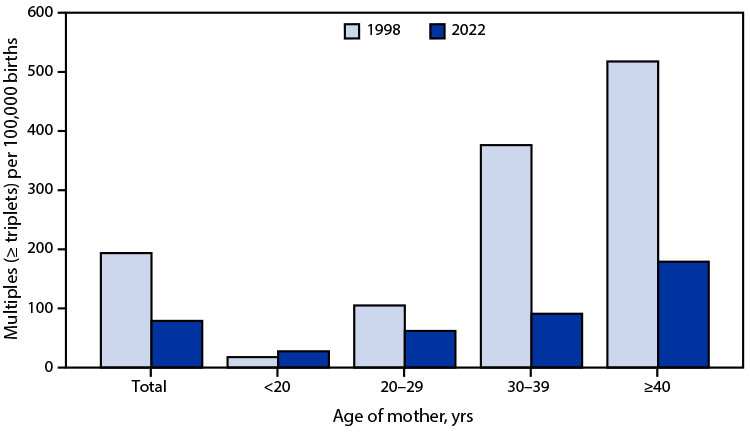
The triplet and higher-order multiple birth rate declined from an all-time high of 193.5 per 100,000 total births in 1998 to 78.9 in 2022. From 1998 to 2022, triplet and higher-order birth rates increased among mothers aged <20 years (from 17.6 to 27.5) but declined among mothers aged ≥20 years. In both 1998 and 2022, Read More >
Posted on byQuickStats: Average Number of Stroke Deaths per Day, by Month and Sex — National Vital Statistics System, United States, 2021
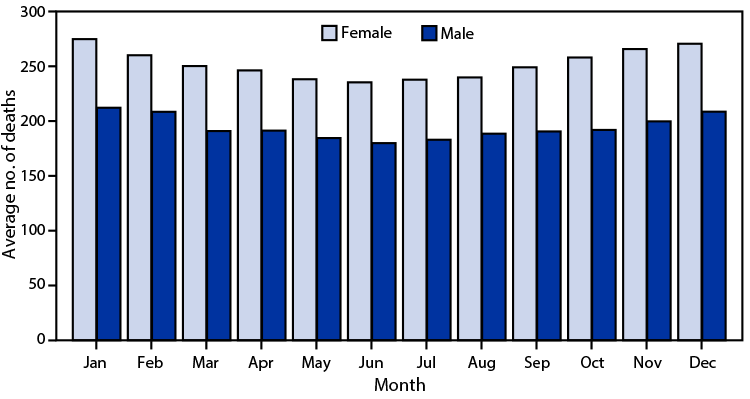
In 2021, the average number of stroke deaths per day was highest in January (275 for females and 212 for males) and then declined to a monthly low in June (235 for females and 180 for males). Beginning in July, the average number of stroke deaths per day increased for each successive month through the Read More >
Posted on byQuickStats: Age-Adjusted Percentage of Adults Aged ≥18 Years Who Received an Influenza Vaccination During the Past 12 Months, by Sex and Race and Ethnicity — National Health Interview Survey, United States, 2022
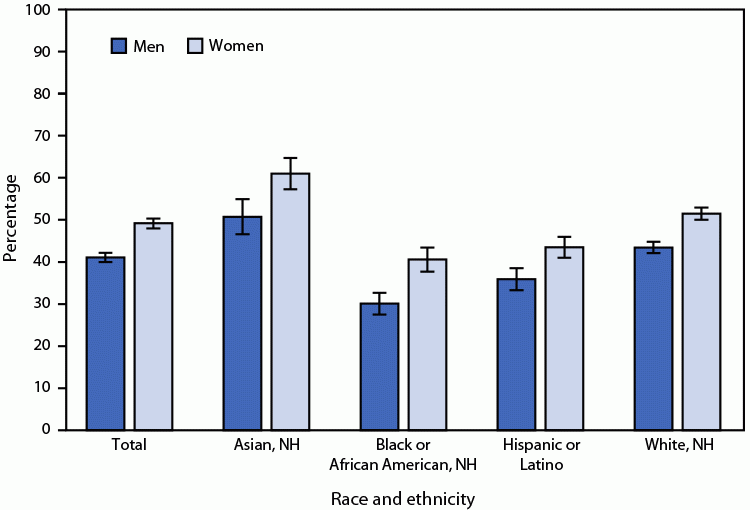
In 2022, among persons aged ≥18 years, women were more likely than were men (49.2% versus 41.1%) to have received an influenza vaccination during the past 12 months. Women were more likely than were men to have received an influenza vaccination among Asian (61.0% versus 50.7%), Black (40.6% versus 30.1%), Hispanic (43.5% versus 35.9%), and Read More >
Posted on byQuickStats: Percentage of Adults Aged ≥18 Years Who Rarely or Never Get the Social and Emotional Support They Need, by Sex and Disability Status — National Health Interview Survey, United States, 2021
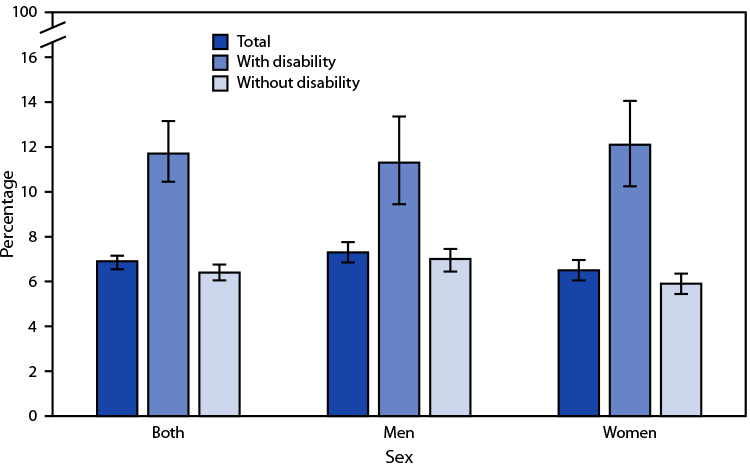
In 2021, 6.9% of adults aged ≥18 years rarely or never got the social and emotional support they needed. Overall, the percentage was higher among those with a disability (11.7%) than among those without disability (6.4%). Among men, 11.3% of those with disability rarely or never got needed support, compared with 7.0% of those without Read More >
Posted on byQuickStats: Percentage of Adults Aged ≥18 Years Who Felt Very Tired or Exhausted Most Days or Every Day in the Past 3 Months, by Sex and Age Group — National Health Interview Survey, United States, 2022
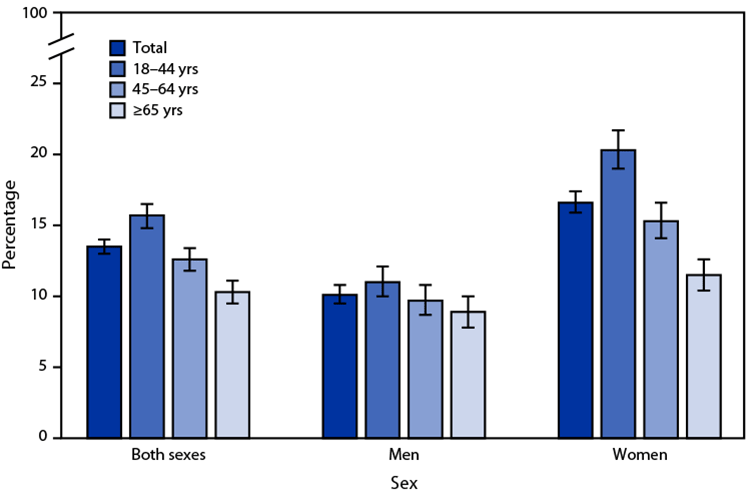
In 2022, 13.5% of adults aged 18 and older felt very tired or exhausted most days or every day in the past 3 months, and this percentage declined with age. Among men, the percentage was highest among those aged 18–44 years (11.0%), followed by those aged 45–64 years (9.7%) and ≥65 years (8.9%). Among women, Read More >
Posted on byQuickStats: Rate of Emergency Department Visits, by Homeless Status — National Hospital Ambulatory Medical Care Survey, United States, 2010–2021
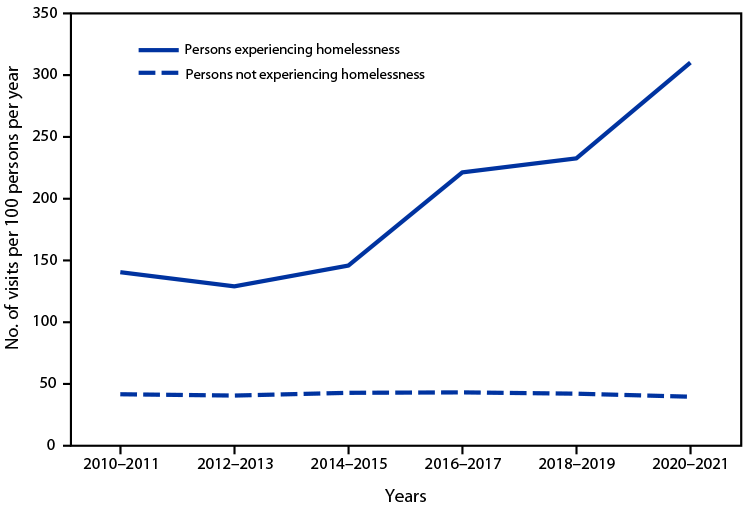
The rate of visits to hospital emergency departments by persons experiencing homelessness increased from an estimated 141 visits per 100 persons per year during 2010–2011 to 310 during 2020–2021. Rates increased during 2016–2017 compared with 2014–2015, and again during 2020–2021 compared with 2018–2019. Visit rates for persons not experiencing homelessness did not vary significantly across Read More >
Posted on byQuickStats: Age-Adjusted Death Rates for Stroke, by Region — National Vital Statistics System, United States, 2001–2021
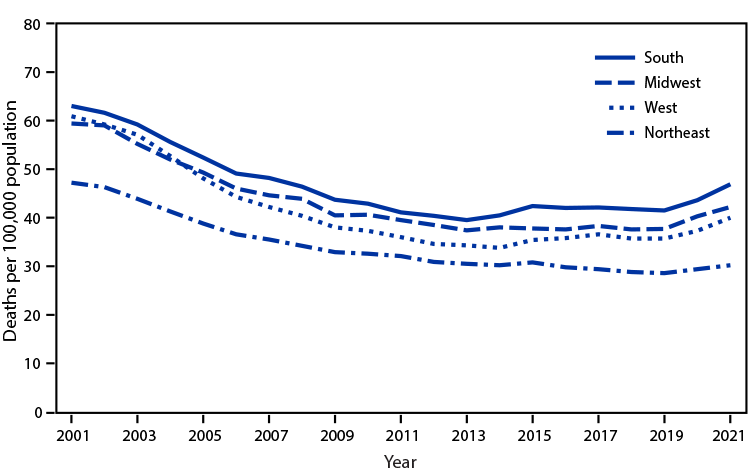
The age-adjusted death rate for stroke declined for all regions from 2001 to 2021. Stroke death rates declined from 2001 through 2013 for persons living in the South (63.0 to 39.5 per 100,000 population) and Midwest (59.4 to 37.4), through 2014 for persons living in the West (60.9 to 33.8), and through 2019 for persons Read More >
Posted on by
